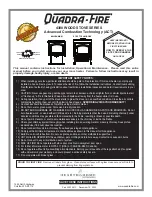
OPERATION
Do not use a grate or elevate fire. Build wood fire directly on hearth. When the stove is used for
the first time the solvents in the paint will smoke off.
I
NSTRUCTION FOR FIRST BURN - CURING THE STOVE PAINT
Your stove has been painted with the highest quality stove paint and has special break-in
procedures. The heat generated by the normal operation of the stove, will serve to harden the
paint.
Ventilate the house
during the first three times the stove is used. The paint on the stove will give
off smoke, carbon dioxide and an odor. Without adequate ventilation, concentrations of smoke
could irritate, or be upsetting.
Open doors and windows and use a fan
if necessary. After the
initial burns the paint will be cured and there should be no more smoke.
Each of the initial burns should be conducted as follows:
A) The 1st 2 burns should be at approximately 250 deg F (120 deg C) for
approximately 20 minutes.
B) The 3rd burn should be between 500 deg F (260 to 370 deg C) for at least
45 minutes. The important fact is the paint should be cured slowly. Avoid
hot fires during the curing process.
During the curing process the paint will be gummy. Once cured the paint will remain hard.
It is normal
to see flat spots on painted surfaces of the stove. The flat spots on the paint surface
indicate the hotter surfaces of the stove, and is caused by the heat radiating thru the paint.
It is also expected that shinny spots
caused by friction from the packaging materials, will
disappear during the curing of the stove.
SO
....
1)
Remember to Ventilate well.
2) Allow the stove to cure before burning for long periods at high temperatures.
3) Flat spots on the painted surfaces are normal.
4) Shinny spots on the paint surface before burning is normal.
5) Call your dealer if you have any questions.
Wood
This heater is designed to burn natural wood only. Higher efficiencies and lower emissions
generally result when burning air dried seasoned hardwoods, as compared to softwoods or to
green or freshly cut hardwoods.
Only use dry seasoned wood. Green wood, besides burning at only 60 percent of the fuel value of
dry wood, deposits creosote on the inside of your stove and along the chimney. This can cause an
extreme danger of chimney fire. To be called "seasoned", wood must be dried for a year.
Regardless of whether the wood is green or seasoned, it should be stored in a well-sheltered,
ventilated area to allow proper drying during the year to come. Wood should be stored beyond
recommended clearance from combustibles.
DO NOT BURN:
*
Treated Wood
*
Solvents
*
Trash
*
Coal
*
Garbage
*
Cardboard
*
Coloured Papers
12





































